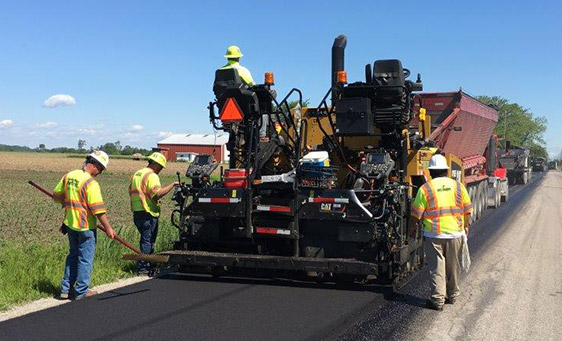Transform Your Building's Landscape with Hot Mix Asphalt Paving Excellence
Transform Your Building's Landscape with Hot Mix Asphalt Paving Excellence
Blog Article
Unlocking the Secrets of Hot Mix Asphalt Innovation
Checking out the midsts of warm mix asphalt innovation discovers a globe where meticulous processes and accurate formulations converge to shape our roadways and framework. The blend of fillers, accumulations, and binders isn't just a building and construction job however a calculated orchestration of sturdiness and effectiveness. As we peer into the elaborate dance of parts, a tapestry of strength and sustainability unravels. What exists underneath this surface of asphaltic mastery, and what keys wait to be revealed in the realm of leading developments?
Importance of Warm Mix Asphalt
Hot Mix Asphalt plays a critical role in modern infrastructure advancement due to its toughness and cost-effectiveness. As the most commonly made use of leading material for roads, freeways, and car park great deals, Warm Mix Asphalt provides an array of benefits that contribute to its significance in building jobs.
The toughness of Warm Mix Asphalt comes from its make-up, that includes accumulations, binder, and filler products that are very carefully chosen and mixed to meet certain performance demands. This exact mix causes a solid and adaptable sidewalk that can withstand regular use without significant damage. Hot Mix Asphalt is 100% recyclable, further boosting its sustainability and ecological benefits. Overall, the importance of Warm Mix Asphalt in facilities development can not be underrated, as it remains to be a keystone of contemporary construction techniques.
Components of Asphalt Mixes
The composition of asphalt mixes is composed of very carefully picked aggregates, binder, and filler materials that are critical for accomplishing certain efficiency needs. Aggregates are the primary element of asphalt blends, giving toughness and stability. The binder, generally bitumen or asphalt cement, holds the aggregates with each other and supplies flexibility and durability to the mix.
The combination and proportion of these components play a significant role in identifying the high quality and performance of the asphalt mix. Engineers meticulously make the mix to satisfy specific needs, considering factors like traffic quantity, environment problems, and pavement life expectancy. Appropriate choice and balancing of aggregates, binder, and fillers are vital for producing resilient, lasting asphalt pavements.
Combining and Manufacturing Techniques

As soon as the accumulations are picked, the binder, often asphalt cement, is contributed to bind the materials with each other. The binder's top quality and amount significantly affect the mix's adaptability, toughness, and resistance to environmental aspects. Furthermore, fillers like hydrated lime or Portland concrete may be integrated to enhance specific characteristics of the asphalt mix, such as its workability or dampness resistance.
Throughout manufacturing, the accumulations and binder are heated up, normally between 250-325 ° F(121-163 ° C ), to facilitate blending and make sure appropriate covering of the aggregates. The blending process should be comprehensive to attain an uniform blend that promotes the wanted performance qualities of the asphalt. Various strategies, such as batch mixing or drum blending, are utilized to achieve regular and top notch asphalt mixes for construction tasks.
Elements Affecting Asphalt Efficiency
Elements from this source affecting asphalt efficiency encompass a variety of variables that influence the resilience, durability, and total high quality of asphalt sidewalks. One vital factor is the high quality of products made use of in the asphalt mix.

Environmental problems also affect asphalt performance. Temperature variants, moisture seepage, and traffic tons can all impact the structural honesty of the pavement. Style factors to consider, such as pavement thickness and water drainage, are important in making certain the long-term performance of the asphalt sidewalk. By carefully thinking about these designers, variables and contractors can enhance asphalt efficiency and boost the life span of pavements.
Lasting Practices in Asphalt Modern Technology

Furthermore, the development of warm-mix asphalt (WMA) technologies has obtained grip in recent years. WMA permits Discover More the manufacturing and positioning of asphalt mixes at reduced temperature levels compared to traditional hot-mix asphalt, causing minimized energy intake and greenhouse gas discharges. Additionally, using permeable asphalt mixes can help minimize stormwater overflow issues by permitting water to infiltrate through the sidewalk and into the ground, advertising natural water purification and charge processes. By implementing these sustainable practices, the asphalt market can add to building a more eco-friendly and durable framework network.
Conclusion
To conclude, hot mix asphalt innovation plays a critical role in modern facilities advancement as a result of its sturdiness and cost-effectiveness. By very carefully balancing elements, utilizing appropriate mixing strategies, and considering various elements, engineers can create premium asphalt mixes that endure rush hour loads and harsh climate condition. Welcoming lasting methods, such as utilizing warm-mix modern technologies and recycled products, better boosts the ecological friendliness of asphalt technology.
Blending and production techniques in warm mix asphalt innovation involve the precise mix and processing of accumulations, binder, and fillers to produce her comment is here a resilient and high-performance asphalt mix.Variables affecting asphalt performance incorporate a variety of variables that impact the durability, long life, and general quality of asphalt sidewalks. Sustainable techniques in asphalt innovation encompass numerous initiatives intended at decreasing the ecological effect of asphalt manufacturing and paving processes. By including recovered asphalt sidewalk (RAP) and recycled asphalt roof shingles (RAS) into brand-new asphalt mixes, the market can significantly minimize the consumption of raw products and power, while likewise lowering garbage dump waste.
WMA permits for the production and positioning of asphalt blends at lower temperature levels compared to standard hot-mix asphalt, resulting in reduced energy intake and greenhouse gas emissions.
Report this page